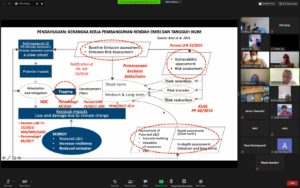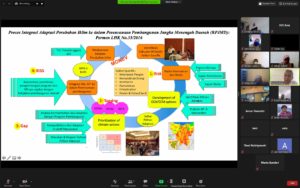The IUC Asia, in partnership with the CCROM – IPB, conducted a capacity building workshop with Malang’s official agencies as part of its climate action plan development. The workshop was designed to provide the knowledge for developing a climate change adaptation plan, emphasizing climate risk and vulnerability assessments (CRVA).
Symptoms of changing climate have implications for Indonesia’s environmental and socio-economic situation. Just as environmental management and development affect each other, climate change poses a risk to development—and development planning should take account of the anticipated impacts of climate change.
Efforts to mainstream climate change adaptation into regional development planning are still at a relatively early stage in cities across Indonesia, although relevant and useful tools have been created by the Government of Indonesia. The workshop highlighted the mainstreaming process, comprised of the following steps:
- Undertaking climate risk and vulnerability assessments (CRVA) to identify population groups, geographical location and sectors that are currently the most vulnerable.
- Identifying the development strategies that address the urban planning issue and deliver specified climate change benefits, helping to identify the priority actions.
- Conducting analysis based on priority actions in step 2 and risk level result in step 1. It would provide the list of possible adaptation measures that address the question 4W1H (What=the possible measures; Where=the geographical location; When= time implementation based on financing availability and urgency level; Who=responsible institution ; How = method of monitoring program).
- Implementing improvement measures to create a synergy program either within the sector or across the sector.
The workshop underlined that climate risk and vulnerability assessments are a critical step, concerned with the current climatic trends and/or projected future climate change in specific geographical areas; vulnerabilities of local natural systems and/or communities to current or projected climate-related impacts; climate-related risks in specific sectors and possible adaptation measures. SIDIK as a CRVA tool developed by the Ministry of Environment and Forestry was introduced in the workshop. It presented data and information on the vulnerability index at provincial to village-level data across Indonesia, where the level of vulnerability was determined by the indicators. The participants also discussed the availability of data from several institutions to add as SIDIK indicators for setting the exposure, sensitivity and adaptive capacity.








